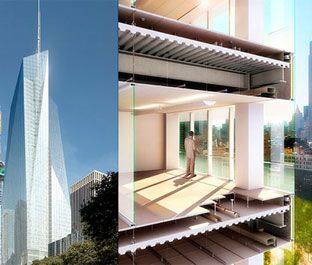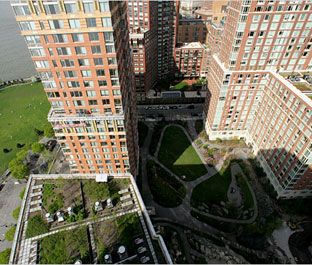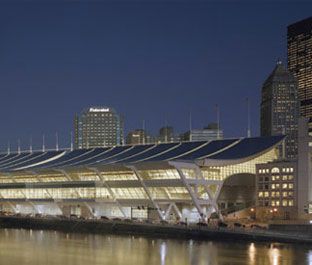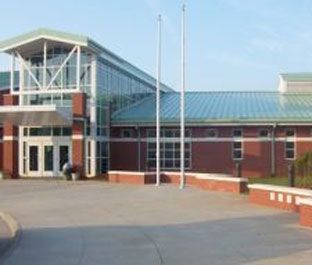[pagebreak:GreenBuildingPrimerLEEDDefined]
LEED or -- incorrect but far more common -- LEEDs is one of the hot new words being tossed around by the building industry, realtors and just about anybody who aspires to be "green." Most people use the word as a replacement for the word "green" when referring to green buildings, but not many people seem to actually know what it means.
The nine* rating systems are:
- New Commercial Construction and Major Renovations: "LEED for New Construction and Major Renovations is a green building-rating system that was designed to guide and distinguish high-performance commercial and institutional projects, with a focus on office buildings." (USGBC Website)
- Existing Buildings: For existing construction that is being renovated or rehabilitated as a green building.
- Commercial Interiors: "LEED for Commercial Interiors gives the power to make sustainable choices to tenants and designers, who do not always have control over whole building operations." (USGBC Website)
- Core and Shell: "Broadly defined, core and shell construction covers base building elements, such as the structure, envelope and building-level systems, such as central HVAC, etc. The LEED for Core and Shell product recognizes that the division between owner and tenant responsibility for certain elements of the building varies between markets.
"LEED for Core and Shell is designed to be complementary to the LEED for Commercial Interiors Green Building Rating System." (USGBC Website)
- LEED for Homes: LEED for Homes is a voluntary rating system. It is intended to promote the design and construction of high-performance green homes.
- LEED for Schools: Specifically designed for K-12 schools. It addresses issues such as acoustics, master planning and children's health.
- Neighborhood Development: This rating system integrates the principles of smart growth, urbanism and green building into the first national standard for neighborhood design.
- Healthcare: This rating system "promotes sustainable planning, design and construction for high-performance healthcare facilities."
- Homes: LEED rating allows private home builders to certify their green and sustainable homes.
- *There are also several other rating systems in development. Current rating systems are constantly being updated as well.
[pagebreak:Why Go LEED?]
Why Go LEED?
Certifying a building has many benefits, including user health, environmental protection, lower long-term costs and increasingly more government tax credits. And it's not hard to convince a large company in the public eye to go green. It's great PR, and that can go a long way.
The biggest down side to building green is the initial cost. It is perceived as high and not worth the investment because no one is talking about the maintenance or investment return offered by a LEED-certified building. Currently, making a building green costs about $3 per square foot more than constructing a conventional building -- which is a big turn-off for many builders. But the savings over time is about $73 per square foot in energy costs. As the market heads more and more down a green path, the initial cost will become lower and may even surpass traditional building method costs. "[Sustainable and green building] needs to be democratic -- available for everyone," says Azizan Aziz, a senior researcher and adjunct assistant professor at Carnegie Mellon University's Center for Building Performance and Diagnostics, "and cost makes it democratic. Only 3 percent of total new construction is green, but there is a huge opportunity out there. Make it simple, make it understandable." By having a nationally recognized rating system in place, LEED becomes less of an idea and more of an implementation.
Another downside to certification is the "paperwork" (although LEED certification is done entirely on the Internet in an attempt to be paperless). Each point you receive needs to be documented and a form needs to be filled out. For some, this is more of a turn-off than cost. In some areas, building permits are expedited for green buildings, which can be a big incentive for some. However, many builders are following the guidelines of LEED, but skipping the certification process because at the end of the day, as long as your building is actually sustainable, the seal of approval from the USGBC is inconsequential.
It's easiest to quantify the soft cost savings in LEED-certified schools (see pdf Greening America's Schools: Cost and Benefits). Studies have shown that sick days for teachers and students are significantly lower, test scores increase and teacher retention is higher than in a traditional school building.
LEED certification has become an important and fundamental part of the "green movement." "People talk about green stuff, but what is green? LEED helps define that [green]. It's a benchmark for people," says Aziz. In response to the question of why go LEED, Aziz says, "It's the right thing to do. Why really destroy the environment? I think it's our responsibility."
At the moment, people don't really know enough about LEED, but that number is decreasing. The market is growing and the population is becoming more aware. An important part of understanding LEED is that it starts at beginning of a project. It is not an add-on or an afterthought. The idea is to integrate sustainability into original design. "It's just common sense, integrated design. I mean why wouldn't you do that?" says Aziz.
[pagebreak:Rating System Overview]
Rating System Overview
Professionals who are interested in the LEED program must take an exam to become a LEED Accredited Professional (AP). Once they have successfully become accredited, they can be hired as a LEED consultant. In fact, having a LEED AP as a principal on the project gets one point toward certification! The LEED AP usually leads the way in getting the project certified by managing the requirements submitted online via the USGBC website. The website is the comprehensive guide to certifying a building and all documentation must be submitted through its online interface.
NOTE: All information pertaining to points and details of the rating system is based on New Construction V2.2 -- for information on other rating systems, please visit the USGBC website.
There are 4 levels of certification. They are as follows:
- LEED Certified: 26-32 points
- LEED Silver: 33-38 points
- LEED Gold: 39-51 points
- LEED Platinum: 52-69 points
Within the rating system, there are six categories. In most categories there is at least one prerequisite. This applicable condition must be met in every category in order to qualify for certification. Prerequisites do not count as points.
The following sections contain a brief overview of the rating system. The actual handbook is about 500 pages and includes suggestions for implementation of each credit.
The LEED rating system uses codes that are already in existence as a baseline for building guides. Most commonly, it uses existing ASHRAE (American Society of Heating, Refrigerating and Air-Conditioning Engineers) codes.
- Sustainable Sites
- Water Efficiency
- Energy and Atmosphere
- Materials and Resources
- Indoor Environmental Quality
- Innovation in Design and Process
[pagebreak:Rating System Overview]
Rating System Overview
Sustainable Sites -- 14 Possible Points, 1 Prerequisite
This is the first category. It deals with choosing a site that has a minimal effect on the ecosystem and then managing the site in an environmentally responsible way. This includes stormwater management, habitat/plant species management, light pollution and heat island effect reduction.
Heat island effect is an area in which "urban and suburban temperatures that are 2 to 10°F (1 to 6°C) hotter than nearby rural areas." (EPA) These elevated temperatures can cause a variety of issues, including increase in peak power demands for cooling, pollution and heat-related illnesses. Credits 7.1 and 7.2 deal with heat island effect reduction both in non-roof and roof applications, respectively.
Sustainable Sites also encompasses transportation to and from the site including public transportation, parking issues and biking. Other credits in this category are awarded for convenience of amenities in the area for building occupants to reduce local travel.
The prerequisite for this category is Construction Activity Pollution Prevention. The purpose of this prerequisite is to "reduce pollution from construction activities by controlling soil erosion, waterway sedimentation and airborne dust generation." To achieve this, the project team must create and implement a site-management plan to reduce construction pollution and waste -- before the project begins.
Water Efficiency -- 5 Possible Points, No Prerequisite
The purpose of the Water Efficiency points is to manage the water use on the site and in the building. It deals with the reduction of wastewater from the site and rainwater and greywater use for as many applications as possible.
Energy and Atmosphere -- 17 Possible Points, 3 Prerequisites
This category is designed to reduce the amount of pollution that is put into the atmosphere by a building and to optimize its energy performance. A project can attain points by implementing strategies such as creating an efficient building envelope to optimize energy performance. Points are also awarded for on-site renewable-energy mechanisms such as solar power and wind power, or for using off-site green power (i.e. utility companies that offer renewable power options).
The first prerequisite for this category is Fundamental Commissioning of the Building Energy Systems. This essentially means that the energy systems being installed and implemented in the building are verified for optimum performance and conform to the standards set out by the project team. This prerequisite makes use of a third-party commissioning agent for accurate and objective data collection and analysis.
Minimum Energy Performance is the second prerequisite. This requirement is to ensure that the building is minimizing energy flows through the building envelope, windows and doors. ASHRAE 90.1 is the code used to meet this prerequisite. It prescribes the amount of insulation, glass types, door types, etc. to meet a minimum energy performance.
The goal of the third prerequisite, Fundamental Refrigerant Management, is to reduce ozone depletion. There must be zero use of CFC-based refrigerants in new construction or, for renovations, there must be a CFC phase-out.
[pagebreak:Rating System Overview]
Rating System Overview
Materials and Resources -- 13 Possible Points, 1 Pre-Requisite
This category encompasses recycling, existing building and material reuse, construction waste, recycled and renewable materials and local resources. Within the building-reuse criteria, a project can achieve several points depending on the percentage of existing building structure and materials that are salvaged for reuse. This is the same scenario for recycled materials, locally available (within a 500-mile radius of the site) and renewable materials. A point is also given specifically for the use of wood certified by the FSC (Forest Stewardship Council).
As part of this category, a point can be acquired by diverting 75 percent of the construction waste from a landfill. Solutions include recycling the packaging and waste materials and/or reusing the packaging and waste materials (i.e. giving once-used pallets to suppliers when they deliver goods).
The prerequisite requires that a site recycling storage and collection plan be created and executed for use by building occupants. The facility must be easily accessible to all occupants.
Indoor Environmental Quality -- 15 Possible Points, 2 Prerequisites
Part of what makes a green building green is the quality of the environment in which occupants will be working or living. The purpose of the Indoor Environmental Quality (IEQ) points is to promote the well-being of building occupants through a quality environment. All LEED-certified buildings are required to have either a no-smoking policy or have designated indoor smoking areas that are properly sealed off from the main building HVAC and ventilated to the outside. The second prerequisite is that a minimum of air quality must be met and maintained. This minimum is determined by the ASHRAE code for Indoor Air Quality (IAQ). IEQ also deals with ventilation issues such as constant monitoring of the IAQ and maximizing ventilation.
Points are also given for IAQ throughout all phases of construction. This can be achieved by creating an IAQ plan for construction, using low VOC- (Volatile Organic Compounds-) emitting materials, airing out and ventilating the space before occupancy and installing separate ventilation systems for areas that will have hazardous chemicals in them during occupancy.
Lighting and temperature control are another key aspect of having a high IEQ. LEED gives points for high individual and group controllability of lighting and temperature as well as incorporation of daylight into occupied spaces. Points are awarded for continuous monitoring of thermal comfort during building occupancy.
Innovation in Design and Process -- 5 points available
The final category is designed to provide teams and projects with extra points for exceptional performance above and beyond the standards in place. Additional points can also be awarded for innovative ideas that are not specifically addressed by the LEED Rating System.
One point is awarded for having a LEED AP as a project principal.
LEED recognizes that technology and materials are constantly changing. At any time, projects can submit other innovative solutions that address any of the above credits. These will be evaluated by the USGBC and LEED and points will be thusly awarded.
Although LEED certification generally applies to buildings in the U.S., many international projects are being certified per the LEED rating system in countries such as China, India and Canada.
[pagebreak:Case Studies: Bank of America Tower] 
Case Study: Bank of America Tower
Bank of America Tower, One Bryant Park, New York City
Commissioned by: the Durst Organization and Bank of America
Architect: Cook + Fox Architects
Additional Collaborators:The Natural Resources Defense Council (NRDC), The Rocky Mountain Institute (RMI), The New York State Energy Resource Development Authority (NYSERDA), United States Department of Energy (DOE)
LEED Status:Platinum
This building, slated for completion in early 2008, will be the first LEED Platinum office building.
Cook + Fox has a reputation for green and sustainable architecture. One of the most notable features of this building is the co-generation plant in the basement. The tower will be creating its own power and then using the excess produced for a thermal storage system. The "thermal storage system at basement level produces ice in the evening when electricity rates are lowest to reduce peak daytime demand loads on the city." (Cook + Fox)
Other features of the building include:
- A filtered under-floor displacement air-ventilation system and floor-by-floor air-handling units;
- Carbon-dioxide monitors automatically adjust the amount of outdoor air when necessary. Unfortunately,
- depending on where the building is located, there is no guarantee that the outdoor air is fresh;
- Graywater system that captures and reuses all rainwater and wastewater;
- Waterless urinals and low-flow fixtures;
- Anaerobic digester plant converts food waste into electricity.
[pagebreak:Case Studies: The Solaire] 
Case Study: The Solaire
The Solaire, Tribeca, New York City
Developed by: the Albanese Organization, Inc
Architects: Cesar Pelli and Associates Architects and Schuman, Lichtenstein, Claman, Efron Architects
LEED Status: Gold
The Solaire is one of the first LEED-certified multifamily residences. Its biggest innovation is an on-site wastewater-treatment facility. It is the first treatment facility to be built inside a multifamily residence and is particularly notable because these facilities are not often seen in urban settings.
In an effort to even further reduce water use, they have a stormwater collection and reuse system as well. All the residences are also furnished with low-water usage appliances.
As the name would suggest, energy is procured through on-site solar panels. A resident-usable rooftop garden helps to insulate and cool the buildings as well.
[pagebreak:Case Studies: David Lawrence Convention Center] 
Case Study: David Lawrence Convention Center
The David Lawrence Convention Center, Pittsburgh, Pennsylvania
Owner: The Sports & Exhibition Authority of Pittsburgh and Allegheny County (SEA)
Architects: Rafael Vinoly Architects
LEED Status: Gold
The David L. Lawrence Convention Center in Pittsburgh is the first LEED-certified convention center as well as the world's largest green building. The convention center has implemented a water-reclamation system that is able to reduce water consumption by 60 percent. Vinoly has also made use of the building's location on the Allegheny River for a natural ventilation system that helps to reduce energy use and cost. The building primarily relies upon daylighting for interior spaces and has daylight sensors that control artificial lighting.
[pagebreak:Case Studies: Third Creek Elementary School] 
Case Study: Third Creek Elementary School
Third Creek Elementary School, Statesville, North Carolina
Owner: the Iredell-Statesville Schools
Architects: Moseley Architects
LEED Status: Gold
Third Creek Elementary School is the first K-12 school to be LEED Gold certified. The architectural firm, Moseley Architects, is well-known for building schools and government service buildings. The school incorporates natural daylight into all of the classrooms and employs waterless urinals to reduce water consumption. Majority of the building materials are low-VOC and do not create an unhealthy environment for the students. For heating and cooling, the building uses energy-efficient water-source heat pumps. It has also made use of the natural landscape to help filter and slow stormwater run-off. The wetland that the building sits on is used as a “living classroom” for the students.


